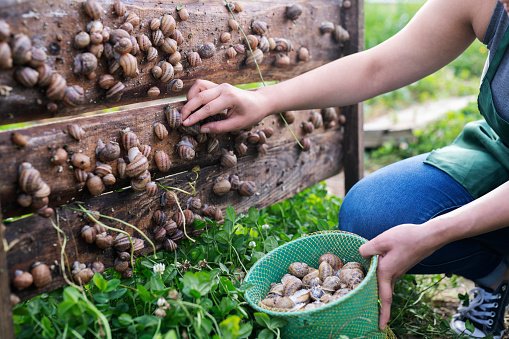Introduction.
Starting a snail farming business in Nigeria is one of the smartest investments you can make if you’re looking for a venture that’s low-risk, affordable, and highly profitable. Snails might seem small, but they pack a lot of potential in the agricultural market.
With their high demand in local and international markets and their simple farming requirements, snail farming is quickly becoming a go-to business idea for entrepreneurs.
Let me walk you through everything you need to know to start a snail farming business in Nigeria—from understanding the basics to setting up your farm and growing your profits.
Why Snail Farming?
Snail farming has so much going for it. For starters, the demand for snails is high, especially among health-conscious individuals.
Snails are rich in protein, iron, calcium, and essential amino acids, making them a popular choice for nutritious meals. Beyond their health benefits, they’re also in demand for cosmetics and pharmaceutical products.
Another great thing is that snail farming doesn’t need too much startup capital. Unlike poultry or cattle farming, it doesn’t require expensive feed or high-maintenance infrastructure.
It’s also eco-friendly and doesn’t disturb neighbours with noise or odours. Plus, snails reproduce quickly, so your farm can grow steadily over time.
Understanding Snail Farming
Before jumping in, it’s important to know the basics. There are different species of snails, but the African giant land snail (Achatina achatina), Achatina fulica, and Archachatina marginata are the most common and profitable ones in Nigeria.
Snails are best suited to humid environments, making Nigeria’s climate perfect for farming them. However, they’re sensitive creatures that require proper care and management.
How Do I Start a Snail Farming Business?
1. Choose the Right Location
Snails thrive in moist, shaded environments. Look for a location with good drainage and natural shade. Your farm can be as simple as a small backyard setup or a larger piece of land, depending on your budget and goals.
2. Build a Suitable Pen
The pen is where the snails will live, so it needs to be well-designed. Snails need protection from predators like rats, birds, and lizards.
You can build a simple wooden or concrete pen, or use a trench or a greenhouse structure. Cover the pen with a fine mesh or net to keep the snails safe.
Ensure the pen is well-ventilated and humid, as these are key to snail survival. It’s also essential to use soft soil in the pen, as snails lay their eggs in the soil.
3. Select the Right Snails
Choose healthy, mature snails for breeding. They should have strong, unbroken shells and be active. You can either gather snails from the wild (especially during the rainy season) or purchase them from existing snail farms or markets.
4. Provide Proper Feeding and Care
Snails eat a wide variety of foods, including vegetables, fruits, and leaves like pawpaw, cabbage, and waterleaf. Avoid giving them salty or acidic foods, as these can harm them.
Regularly clean their pen to keep them healthy, and provide a shallow water dish for hydration. Also, check the soil to ensure it stays moist but not waterlogged.
5. Monitor Reproduction and Growth
Snails reproduce quickly under the right conditions. A single snail can lay hundreds of eggs in one year. After about 21–40 days, the eggs will hatch, and the baby snails will begin to grow.
Monitor their growth and separate smaller snails from larger ones to prevent competition for food.
6. Harvesting and Selling
Snails are ready for harvest once they reach maturity, usually after 8–12 months. You can sell them live or process them for meat.
Markets include local restaurants, hotels, open markets, supermarkets, and even export opportunities.
When selling, focus on building relationships with buyers and ensuring you deliver quality products consistently.
Common Challenges and How to Overcome Them
- Predators and Pests: Protect your snails with secure pens and proper covers.
- Diseases: Maintain a clean and hygienic farm to prevent infections.
- Marketing: Build a strong network and leverage social media to reach potential buyers.
FAQs
How much money do I need to start snail farming?
You can start small with as little as ₦50,000–₦100,000, depending on your farm size and setup.
How long does it take for snails to mature?
Snails typically mature in 8–12 months, depending on the species and care they receive.
What kind of snails are best for farming in Nigeria?
The African giant land snail (Achatina achatina), Achatina fulica, and Archachatina marginata are the most profitable options in Nigeria.
Can I export snails?
Yes, there’s a significant international demand for snails, especially in Europe and America. You’ll need to meet export regulations and package them properly.
Is snail farming seasonal?
No, snail farming can be done year-round, but they tend to thrive more during the rainy season due to increased humidity.
Conclusion
Starting a snail farming business in Nigeria isn’t just about earning profits—it’s also a way to contribute to sustainable agriculture and meet the growing demand for healthy, nutritious food. With the right knowledge and a bit of dedication, it’s a venture anyone can succeed in.
Are you ready to take the first step in building your snail farming business? What’s holding you back?





GIPHY App Key not set. Please check settings